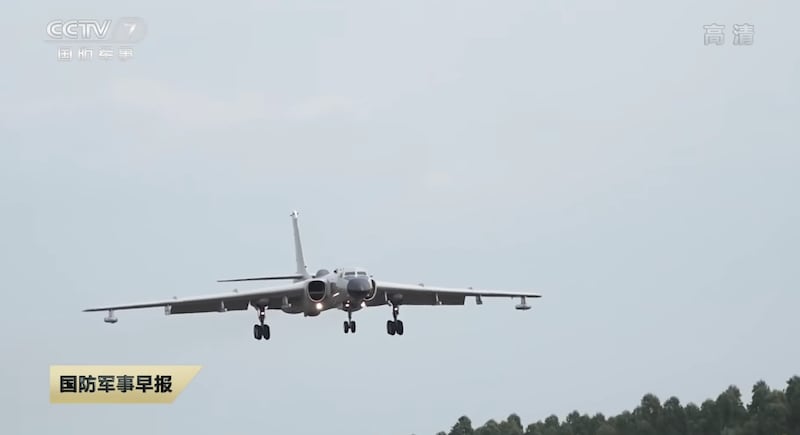The Chinese military has deployed some of its most advanced strategic bombers in a live-fire exercise in the South China Sea as an apparent message of deterrence to Taiwan and its allies.
Several H-6J bombers, the latest type of bomber to enter service with the Chinese People's Liberation Army (PLA) Navy, recently practiced bomb dropping and sea mine-laying on islands in the South China Sea, according to the Global Times, sister publication of China's Communist Party mouthpiece People's Daily. It did not disclose the exact location of the exercise.
The drills, conducted on an unspecified date, “displayed the aircraft’s traditional bombing capability in addition to its standoff strike competence,” reported the Global Times, adding that it involved “the actual use of high-explosive aerial bombs and sea bottom mines.”
China conducts frequent military drills in the South China Sea, where its sweeping territorial and maritime claims overlap with those with several of its neighbors. But it's unusual for China to deploy warplanes to drop bombs and lay mines in a live-fire exercise.
A video clip by China Central Television (CCTV) posted on YouTube on Dec. 2 shows bombers taking off at night and flying through heavy clouds to a designated area of the South China Sea to conduct two air raids.
The planes are seen dropping sea mines and bombs to the sea, causing large columns of explosion. “The bombs hit targets on islands and reefs,” CCTV reported.
The exercise, performed by a regiment affiliated with the PLA Southern Theater Command’s Navy Aviation Force, “could serve as a deterrent at a time when foreign forces and Taiwan secessionists are making provocations,” the Global Times quoted anonymous analysts as saying.
John Blaxland, professor of International Security and Intelligence Studies at the Australian National University, said the action is consistent with “the approach the PLA has taken in recent months to ratchet up the intimidation on the Taiwanese people.”
“This is not surprising, but does not mean that an attack is imminent,” Blaxland said.
While ratcheting up its rhetoric and tactics, according to the Australian analyst, China is expanding its “grey zone” warfare against Taiwan, which “includes cyberattacks, repeated incursions of its air space and territorial waters, and diplomatic isolation to undermine Taiwan’s resolve and ability to resist.”
Beijing regards Taiwan, a self-governing island located about 100 miles (160 kilometers) off the mainland, as part of China, although it views itself as a sovereign state. Taiwan is also a claimant in the South China Sea, along with Brunei, China, Malaysia, the Philippines and Vietnam.

‘Blockade with mines’
Qi Leyi, a Taipei-based military analyst and commentator for RFA Mandarin, said the tense situation across the Taiwan Strait “has not reached the stage of near war yet.”
“However, the blockade of Taiwan by mines is one of the main ways for the PLA to invade Taiwan, when and if it will invade Taiwan, and the Chinese military is certainly seeking to strengthen this capability,” Qi told RFA.
The H-6J strategic bomber was just unveiled by the PLA Navy a year ago. It can carry seven YJ-12 supersonic anti-ship cruise missiles, with six under the wings and one in the weapon bay, Chinese media reported.
The Global Times quoted military experts who said that the H-6J has a combat radius of about 3,500 kilometers (2,200 miles) and the capability “to conduct all-weather combat missions and is also capable of accurately attacking moving maritime targets.”
“Compared with U.S. bombers, the H-6J is actually not that advanced,” said Qi.
“However, it seems to be able to lay mines from the air very fast, and this would be difficult to deal with effectively,” he added.
The PLA has conducted a large number of military exercises across all major sea areas around China this year, with one taking place in the Bohai Strait and the North Yellow Sea at the moment.
Recently, one of China's most powerful Type 055 large destroyers – the 10,000-ton Nanchang - held intensive anti-submarine drills “in an undisclosed area in the Yellow Sea,” the Global Times said.
The Type 055 large destroyer is a class of stealth, guided-missile destroyer with air defense, anti-ship, land-attack and anti-submarine capabilities.
China has reportedly built eight Type 055s, three of them are already in service, Chinese media reported.
